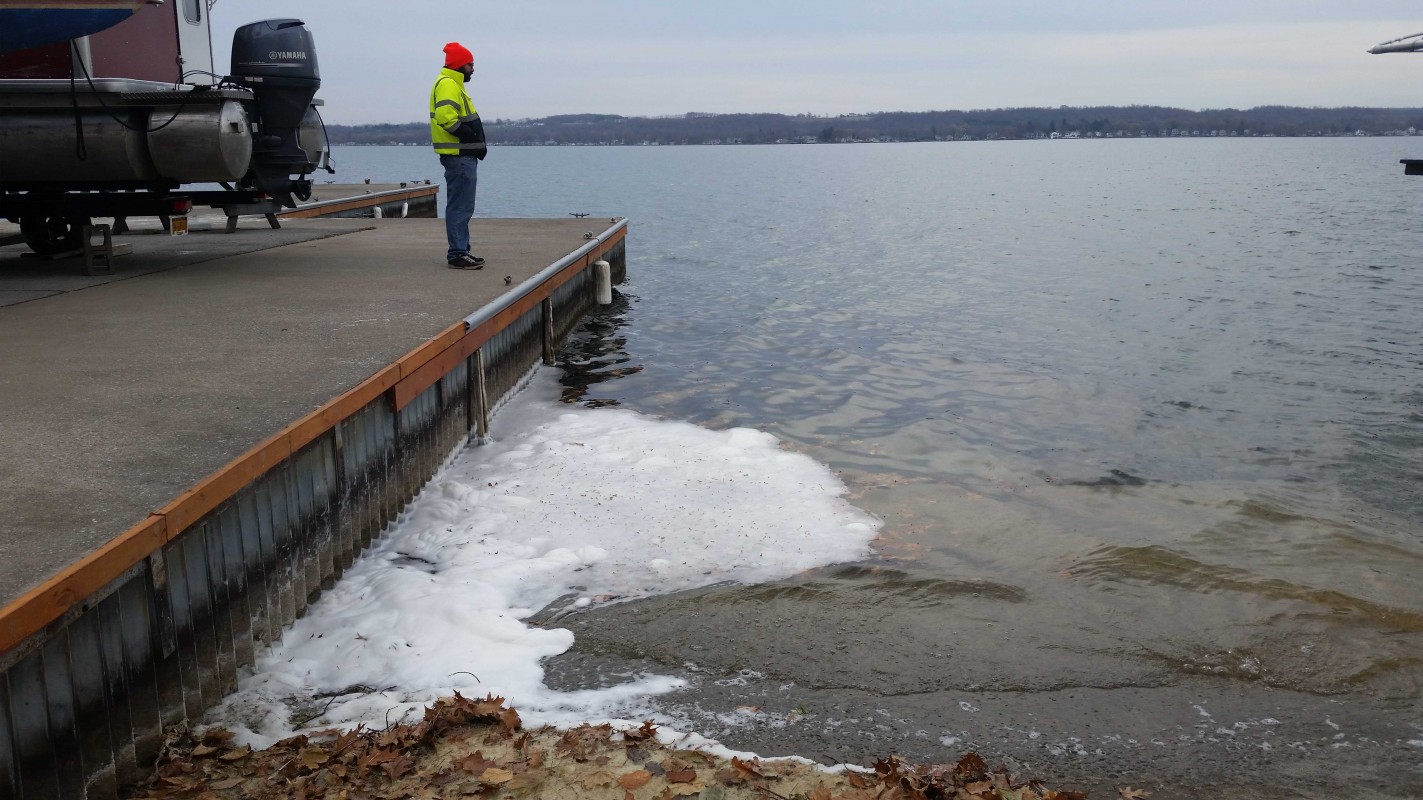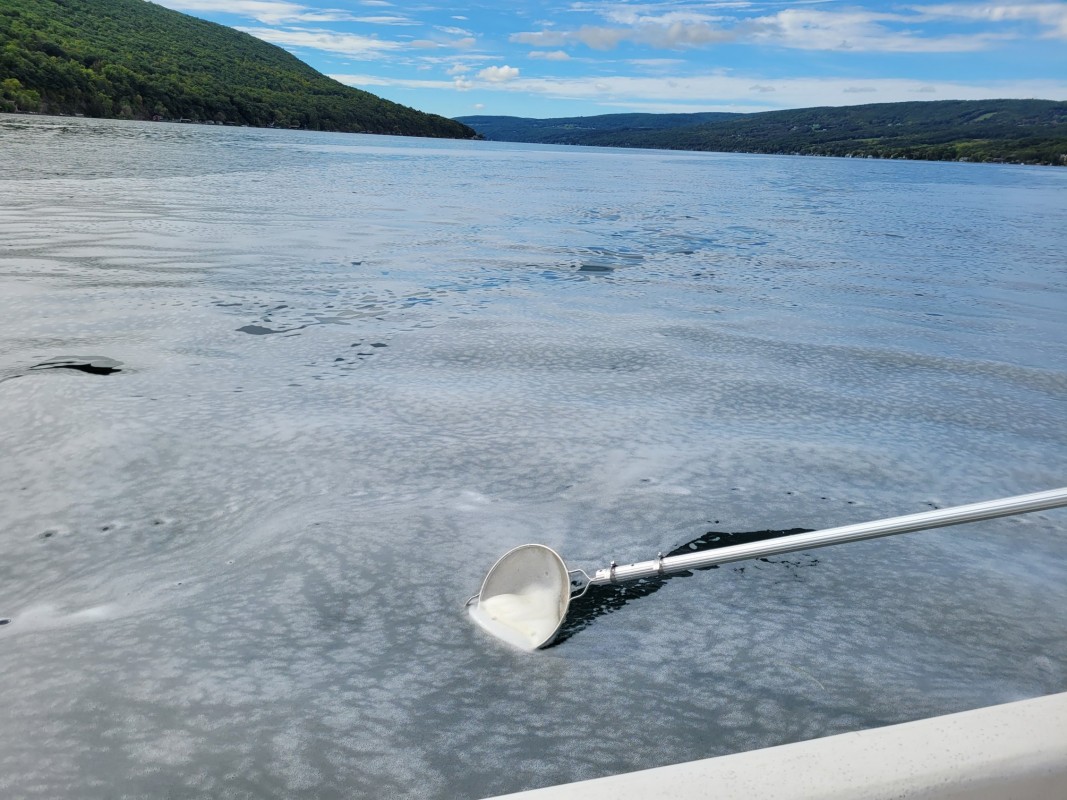Why is PFAS-enriched foam forming on some of the cleanest lakes in the country?
Affiliated faculty in Earth Sciences research the connection between algal blooms and toxic chemicals

A curious phenomenon springs up occasionally on New York’s Finger Lakes: white foam, sometimes in miles-long swathes, almost as if a massive washing machine emptied out into the water.
“These lakes have only been getting algae blooms for less than 10 years; it’s a very new problem,” said Richard W. Smith, founder of Sodus-based Global Aquatic Research.
Smith and colleague Stella C. Woodard are both affiliated faculty in Binghamton University’s Earth Sciences Department. After the appearance of frothy white foam on Canandaigua Lake, the Canandaigua Lake Watershed Association (CLWA) hired their environmental consulting firm to investigate the foam and its connection to algal blooms.
So far, their research has taken them to Canandaigua and later Skaneateles, among the cleanest lakes in the country. Like many of the Finger Lakes, they run deep, with few of the nutrients that typically fuel algal blooms.
“That’s not something we’re used to seeing on clean lakes,” Smith said. “This is a really high-quality water source that provides drinking water for the city of Canandaigua and surrounding communities. Skaneateles Lake provides the drinking water for Syracuse.”
They began by sampling the foam and looking at its chemical makeup. It turns out that algae create a sugar-rich substance that ends up in the top millimeter of water, called the surface microlayer. There, the mucus-like material interacts with other materials — typically pollutants, including per- and polyfluoroalkyl substances (PFAS), polychlorinated biphenyls (PCBs), heavy metals and organic toxins.
The foam forms in the middle of the lake and blows along the shore, picking up surface active compounds along the way. Once on the shoreline, the foam can sit for days until it’s broken up by the rain, wind or waves.
While the algal cells become trapped in the foam, the human-produced compounds are more worrisome; some, such as PFAS, are known as “forever chemicals” because they do not break down in nature.
Potential risks
With the help of grant funding from Freshwater Future, Smith and Woodard analyzed the foam for PFAS. Citizen scientists working with CLWA reported foam observed on Canandaigua Lake, which allowed Smith and Woodard to respond and take samples from three locations.
PFAS consist of carbon chains interspersed with fluorine atoms. While researchers typically only look for a few dozen, there are thousands of potential compounds used in industry. When regulators restrict the use of some compounds, others with a slightly different structure are often engineered to take their place.
Known for being nonstick and water-repellant, the chemicals are ubiquitous in modern life: coating pans and raincoats, mixed into sunscreens, and — not coincidentally — a key component of the firefighting foam used to stop engine fuel fires at airports.
Smith and Woodard tested for 30 known compounds; 18 were found in the foam samples. Only a few fall under current Environmental Protection Agency regulations for drinking water.
The good news: the lake water itself has a very low concentration, at 5.4 parts per trillion. The water that comprises the foam, however, is a different story with over 70 times as much, coming in at 381 to 387 parts per trillion.
That’s likely not a high enough concentration to generate the foam, but the researchers wonder if PFAS play a role in stabilizing it. For the next phase of their project, they will take water samples to Binghamton University Assistant Professor of Systems Science and Industrial Engineering Yuxin Wang and measure the concentration of PFAS in the surface microlayer. The goal is to determine the concentration of the chemicals before the foam forms, since the foam itself is 90% air and 10% water.
After that, they will investigate how these chemicals end up in the surface microlayer. For example: Are they carried by local streams, deposited from the air or churned up from lake sediments? If creeks and rivers carry them, which ones and in what concentrations?
Used in industry and commercial products since the 1940s, PFAS today can be found in environments all over the earth and can accumulate in the body over time, according to the EPA. Their health effects are still being studied, but research has connected the compounds to increased risks of cancer and obesity, decreases in immunity and fertility, and developmental delays in children.

